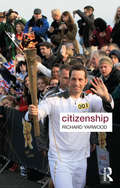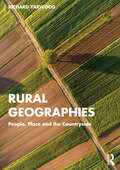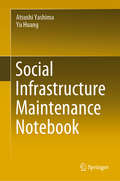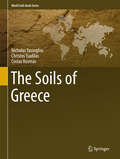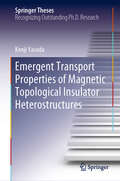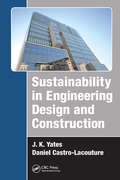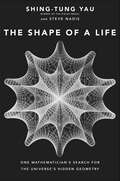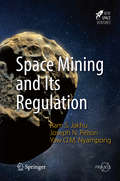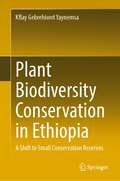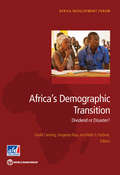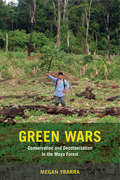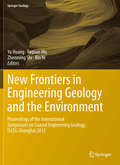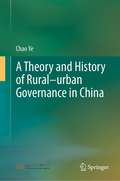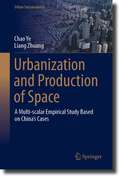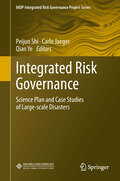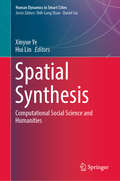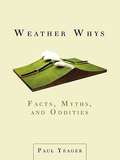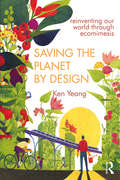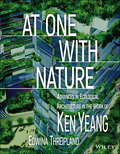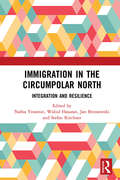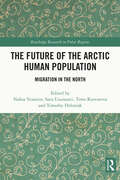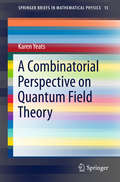- Table View
- List View
Citizenship (Key Ideas in Geography)
by Richard YarwoodThe idea of citizenship is widely used in daily life. ‘Citizenship tests’ are used to determine who can inhabit a country; ‘citizen charters’ have been used to prescribe levels of service provision; ‘citizens’ juries’ are used in planning or policy enquiries; ‘citizenship’ lessons are taught in schools; youth organisations attempt often aim to instil ‘good’ citizenship; ‘active citizens’ are encouraged to contribute voluntary effort to their local communities and campaigners may use ‘citizens’ rights’ to achieve their goals. What is meant by citizenship is never static and the subject of debate by academics, politicians and activists. These ideas are manifest and contested at a range of different scales. This book therefore argues geography is crucial to understanding citizenship. The text is organised around a number of spatial themes to examine how spatialities of citizenship are played out at a range of scales. Ideas about locality, boundaries, mobility, networks, rurality and globalisation are used to reveal the importance of space and place in the constitution, contestation and performance of citizenship. In doing so, the book reveals how different ideas of citizenship can include or exclude people from society and space. Consideration is given to ways in which different groups have sought to empower themselves through various actions associated with and beyond conventional notions of citizenship. Written in an accessible way with detailed case studies to illustrate conceptual ideas and approaches, this book offers social scientists new spatial perspectives on citizenship while also bridging together strands of social, cultural and political geography in ways that deepen understandings of people and place.
Rural Geographies: People, Place and the Countryside
by Richard YarwoodRural Geographies provides a critical, contemporary and accessible introduction to rural change by using geographical ideas to understand current issues affecting the countryside. The book discusses how the countryside has been studied by geographers across a range of different scales, from village community to the global countryside. Each chapter provides a concise and well-illustrated introduction to a key theme in rural geography, using current literature and contemporary examples. The book is divided into four sections that cover rural contexts, changes, contests and cultures. The volume takes a global perspective but is largely centred on the Global North, reflecting the tradition of scholarship in rural geography. Rural Geographies is driven by thinking in human geography. It reflects how major paradigmatic changes in the discipline have impacted, and have been informed by, the sub-discipline of rural geography. The aim is to introduce key ideas and concepts that will teach students the critical skills necessary to analyse rural issues themselves. The text will be a valuable resource for undergraduate students studying rural geography and rural studies.
Social Infrastructure Maintenance Notebook
by Atsushi Yashima Yu HuangThis book explains in an easy-to-understand manner the “check” points to keep in mind when inspecting various social infrastructure structures. It is put together in a way that not only engineers who are on the front line of maintenance and management but also engineers who are not normally involved in maintenance and management of social infrastructures as well as general public can understand the importance of social infrastructure inspection work.
The Soils of Greece
by Nicholas Yassoglou Christos Tsadilas Costas KosmasThis book presents a comprehensive and up-to-date overview on soils of Greece. It includes sections on soil research history, climate, geology, geomorphology, major soil types, soil maps, soil properties, soil classification, soil fertility, land use and vegetation, soil management, soils and humans, soils and industry, future soil issues. The book summarizes what is known about the soils in Greece in a concise and highly reader-friendly way.
International Law in a Transcivilizational World
by Onuma YasuakiThe twenty-first century will witness conflicts which may destabilize the international order. These conflicts are likely to arise between emerging Asian States such as China and India whose material power is growing, and the Western nations who wield significant ideational power. A West-centric international society will change to a multi-polar and multi-civilizational global society. This structural change includes, and further needs, changes of understandings and perceptions of the world, including of international law. The perspectives from which we see, understand, appreciate and assess international law must change. We need to interpret international law not only from a prevalent Statecentric international perspective and West-centric transnational perspective. Onuma argues that we must grasp international law from what he calls a trans-civilizational perspective as well. By adopting such three-layered perspectives, international law is shown to be functioning as a tool of politics yet constrained by cultural and civilizational factors. Such complex subjects as global history of international law, concepts of general and customary international law, and human rights could be appreciated in a more nuanced and subtle manner.
Emergent Transport Properties of Magnetic Topological Insulator Heterostructures (Springer Theses)
by Kenji YasudaThis book reveals unique transport phenomena and functionalities in topological insulators coupled with magnetism and superconductivity. Topological insulators are a recently discovered class of materials that possess a spin-momentum-locked surface state. Their exotic spin texture makes them an exciting platform for investigating emergent phenomena, especially when coupled with magnetism or superconductivity. Focusing on the strong correlation between electricity and magnetism in magnetic topological insulators, the author presents original findings on current-direction-dependent nonreciprocal resistance, current-induced magnetization reversal and chiral edge conduction at the domain wall. In addition, he demonstrates how the coupling between superconductivity and topological surface state leads to substantial nonreciprocal resistance. The author also elucidates the origins of these phenomena and deepens readers’ understanding of the topologically nontrivial electronic state. The book includes several works which are published in top journals and were selected for the President’s Award by the University of Tokyo and for the Ikushi Prize, awarded to distinguished Ph.D. students in Japan.
Sustainability in Engineering Design and Construction
by J. K. Yates Daniel Castro-LacoutureSuccessfully Measure the Benefits of Green Design and Construction Sustainability in Engineering Design and Construction outlines the sustainable practices used in engineering design and construction operations for all types of engineering and construction projects. Aimed at ushering the engineering and construction industry into embracing sustainable practices and green construction techniques, this book addresses sustainability in engineering design and construction operations from a historical and global perspective, and delves into specific sustainability concepts and processes. The book explains the concepts of sustainable development, corporate social responsibility (CSR), the Dow Jones Global Sustainability Index (DJGSI), key performance indicators (KPIs), corporate sustainability, and the triple bottom line (economic, environmental, and social values in design and construction). Relevant to sustainability in every facet of engineering and construction, it also covers life-cycle environmental cost analysis, discusses sustainable engineering and site selection, the economic considerations evaluated when making sustainability decisions, and explains how to measure and quantify sustainable performance and apply these practices in the real world. It also covers project and corporate level sustainability practices, sustainable construction materials and processes, sustainable heavy construction equipment, traditional and alternative energy sources, provides implementation resources for starting and evaluating sustainability programs, and includes a checklist for measuring the sustainability of construction operations. The text contains detailed information on sustainable construction materials and processes, heavy construction equipment, and traditional and alternative energy sources. It presents information on sustainable designs, selecting sustainable sites, designing for passive survivability, designing for disassembly, and the ISO 14,000 standards. It provides implementation resources for starting and evaluating sustainability programs and a checklist for measuring the sustainability of construction operations In addition, it provides definitions of sustainability terms and expressions, as well as case studies, examples, discussion questions, and a list of supplemental references at the end of each chapter. This book provides information on: Definitions for sustainability terms Sources for locating global sustainability requirements Current sustainability issues Environmental laws related to sustainability and their implications Sustainable design Life-cycle cost assessment models Sustainable practices currently being used in the engineering and construction (E&C) industry Corporate-level sustainability practices Project-level sustainability practices Global sustainability trends and implications Sustainable materials Sustainable heavy construction equipment Traditional and alternative energy sources LEED Green Building Rating System Sustainability organizations and certification programs Sustainability implementation resources A summary of sustainable engineering design and construction
The Shape of a Life: One Mathematician's Search for the Universe's Hidden Geometry
by Shing-Tung Yau Steve NadisA Fields medalist recounts his lifelong effort to uncover the geometric shape—the Calabi-Yau manifold—that may store the hidden dimensions of our universe.Harvard geometer Shing-Tung Yau has provided a mathematical foundation for string theory, offered new insights into black holes, and mathematically demonstrated the stability of our universe. In this autobiography, Yau reflects on his improbable journey to becoming one of the world’s most distinguished mathematicians. Beginning with an impoverished childhood in China and Hong Kong, Yau takes readers through his doctoral studies at Berkeley during the height of the Vietnam War protests, his Fields Medal–winning proof of the Calabi conjecture, his return to China, and his pioneering work in geometric analysis. This new branch of geometry, which Yau built up with his friends and colleagues, has paved the way for solutions to several important and previously intransigent problems.With complicated ideas explained for a broad audience, this book offers not only insights into the life of an eminent mathematician, but also an accessible way to understand advanced and highly abstract concepts in mathematics and theoretical physics.“The remarkable story of one of the world’s most accomplished mathematicians . . . Yau’s personal journey—from escaping China as a youngster, leading a gang outside Hong Kong, becoming captivated by mathematics, to making breakthroughs that thrust him on the world stage—inspires us all with humankind’s irrepressible spirit of discovery.” —Brian Greene, New York Times–bestselling author of The Elegant Universe“An unexpectedly intimate look into a highly accomplished man, his colleagues and friends, the development of a new field of geometric analysis, and a glimpse into a truly uncommon mind.” —The Boston Globe“Engaging, eminently readable. . . . For those with a taste for elegant and largely jargon-free explanations of mathematics, The Shape of a Life promises hours of rewarding reading.” —American Scientist
Space Mining and Its Regulation
by Yaw Otu Mankata Nyampong Joseph N. Pelton Ram S. JakhuThis book reviews the current and possible future regulatory oversight of the state and non-state actors now engaged in or planning to become engaged in the exploration and possible exploitation of space related natural resources, whether they be liquid, gaseous, or mineral. An increasing number of countries are also becoming involved in space-related activities that were previously carried out primarily by the US and the USSR (now the Russian Federation). The European Union and its individual member states, Japan, China and India in particular are assuming increasingly important roles in space as in many other areas. Even the United Arab Emirates has announced plans to send a future robotic mission to Mars. As such, exploration, exploitation and utilization of space natural resources are no longer matters to be considered within the exclusive domain of competition and decision-making between the US and the Russian Federation. It is significant to note that, in addition to this new international context, the exploitation of space natural resources is also no longer confined to the traditional domains of science and technology. Regulatory issues abound. These endeavors and how they might be regulated by international treaties, standards, codes of conduct or other means have become a truly international political issue. As a consequence, topics dealing with common concerns - sharing of resources, environment protection, and pollution - easily raise difficulties, as they require different states to agree on common principles having a direct impact on their sovereignty and financial interests. There is yet another new paradigm in the conduct of space activities. While in the past, space activities traditionally fell under the exclusive domain of governmental entities, the last few years have seen the emergence of the private sector of "space entrepreneurs". This poses several challenges for the pre-existing governance regime whose foundations are steeped in the classical State-based conception of international law. As a result, the text examines adequacies and ambiguities in treaty provisions and national laws, currently accepted practices involving the exploration and exploitation of space natural resources that will grow in importance in the coming decades.
Plant Biodiversity Conservation in Ethiopia: A Shift to Small Conservation Reserves
by Kflay Gebrehiwot YaynemsaThis book covers biodiversity conservation under special consideration of the challenges in the global south with particular attention being paid to consider the existing conservation challenges in relation to the study area in Ethiopia. Key issues are addressed, such as the current and future threats to plant biodiversity in Ethiopia, as well as the single large or several small conservation approaches and which approach is feasible for Ethiopia. Furthermore, an innovative approach was developed that enhances ecological connectivity and promotes ecological restoration through community involvement. The book also covers why a systematic conservation planning approach is important and should be used in new protected area establishments, and also looks at the trends of plant ecology research over the past five decades, revealing research gaps and suggesting future research topics. Despite its focus on Ethiopian plant diversity, abundant examples were used from different continents making this book attractive to global readers. It will be of interest for policy- and decision-makers in the conservation sector, researchers interested in biodiversity, climate change, conservation and sustainable use of natural resources, and would be a valuable resource for university students.
Africa's Demographic Transition
by Abdo S. Yazbeck David Canning Sangeeta RajaAfrica is poised on the edge of a potential takeoff to sustained economic growth. This takeoff can be abetted by a demographic dividend from the changes in population age structure. Declines in child mortality, followed by declines in fertility, produce a 'bulge' generation and a large number of working age people, giving a boost to the economy. In the short run lower fertility leads to lower youth dependency rates and greater female labor force participation outside the home. Smaller family sizes also mean more resources to invest in the health and education per child boosting worker productivity. In the long run increased life spans from health improvements mean that this large, high-earning cohort will also want to save for retirement, creating higher savings and investments, leading to further productivity gains. Two things are required for the demographic dividend to generate an African economic takeoff. The first is to speed up the fertility decline that is currently slow or stalled in many countries. The second is economic policies that take advantage of the opportunity offered by demography. While demographic change can produce more, and high quality, workers, this potential workforce needs to be productively employed if Africa is to reap the dividend. However, once underway, the relationship between demographic change and human development works in both directions, creating a virtuous cycle that can accelerate fertility decline, social development, and economic growth. Empirical evidence points to three key factors for speeding the fertility transition: child health, female education, and women's empowerment, particularly through access to family planning. Harnessing the dividend requires job creation for the large youth cohorts entering working age, and encouraging foreign investment until domestic savings and investment increase. The appropriate mix of policies in each country depends on their stage of the demographic transition.
Green Wars: Conservation and Decolonization in the Maya Forest
by Megan YbarraGlobal conservation efforts are celebrated for saving Guatemala’s Maya Forest. This book reveals that the process of protecting lands has been one of racialized dispossession for the Indigenous peoples who live there. Through careful ethnography and archival research, Megan Ybarra shows how conservation efforts have turned Q’eqchi’ Mayas into immigrants on their own land, and how this is part of a larger national effort to make Indigenous peoples into neoliberal citizens. Even as Q’eqchi’s participate in conservation, Green Wars amplifies their call for material decolonization by recognizing the relationship between Indigenous peoples and the land itself.
New Frontiers in Engineering Geology and the Environment: Proceedings of the International Symposium on Coastal Engineering Geology, ISCEG-Shanghai 2012 (Springer Geology #9)
by Bin Ye Yu Huang Faquan Wu Zhenming Shi“New Frontiers in Engineering Geology and the Environment” collects selected papers presented at the International Symposium on Coastal Engineering Geology (ISCEG-Shanghai 2012). These papers involve many subjects – such as engineering geology, natural hazards, geoenvironment and geotechnical engineering – with a primary focus on geological engineering problems in coastal regions. The proceedings provide readers with the latest research results and engineering experiences from academic scientists, leading engineers and industry researchers who are interested in coastal engineering geology and the relevant fields. Yu Huang works at the Department of Geotechnical Engineering, Tongji University, China. Faquan Wu works at the Institute of Geology and Geophysics, Chinese Academy of Science, China and he is also the Secretary General of the International Association for Engineering Geology and the Environment. Zhenming Shi works at the Department of Geotechnical Engineering, Tongji University, China. Bin Ye works at the Department of Geotechnical Engineering, Tongji University, China.
New Frontiers in Engineering Geology and the Environment
by Bin Ye Faquan Wu Yu Huang Zhenming Shi"New Frontiers in Engineering Geology and the Environment" collects selected papers presented at the International Symposium on Coastal Engineering Geology (ISCEG-Shanghai 2012). These papers involve many subjects - such as engineering geology, natural hazards, geoenvironment and geotechnical engineering - with a primary focus on geological engineering problems in coastal regions. The proceedings provide readers with the latest research results and engineering experiences from academic scientists, leading engineers and industry researchers who are interested in coastal engineering geology and the relevant fields. Yu Huang works at the Department of Geotechnical Engineering, Tongji University, China. Faquan Wu works at the Institute of Geology and Geophysics, Chinese Academy of Science, China and he is also the Secretary General of the International Association for Engineering Geology and the Environment. Zhenming Shi works at the Department of Geotechnical Engineering, Tongji University, China. Bin Ye works at the Department of Geotechnical Engineering, Tongji University, China.
A Theory and History of Rural–urban Governance in China
by Chao YeThis book divides the history of China's rural-urban relations into three stages: antagonism, integration and re-antagonism, and demonstrates that the two coupled variables i.e., policy-culture and coast-trade are the most crucial to urbanization and rural-urban governance in China from ancient times till now. From the perspective of a combination of history and geography, this book puts forward a new theory which is mainly based on Adam Smith's theory and other theories about rural-urban relationship and reinterprets the process and driving forces of evolutionary history of rural-urban relationship over 5,000 years in China. It is useful for researchers and scholars specialized in such fields as rural and urban studies, economics, geography, management and planning for reference.
Urbanization and Production of Space: A Multi-scalar Empirical Study Based on China's Cases (Urban Sustainability)
by Chao Ye Liang ZhuangThis book studies China’s urbanization with the theory of production of space. The authors redefine the production of space and build a new theoretical framework for understanding the evolving relations between urbanization and spatial production. Since the reform and opening-up, especially in the last twenty years, the logic of spatial production has dominated China’s urbanization. The authors choose the most representative cases, such as the Yangtze River Delta Urban Agglomeration, Jiangsu Province, National High-tech Industrial Development Zone, New Urban District, State-Level New Area, University Town, and some villages, to conduct a series of empirical studies on production of space at the macro-, meso-, and micro-scales. Through an in-depth analysis of the interaction between social spaces and urbanization influenced by power, capital, and class, the book reveals that the essence of China’s urbanization is dominated by the logic of spatial production. The authors finally propose that an important shift toward humanism should be made in the future development of China’s new-type urbanization, emphasizing more even and adequate development between different regions and between urban and rural areas, which also provides new ideas for the theory and practice of urbanization worldwide.This book can be read and referenced by researchers in the fields of urban and regional studies, geography, sociology, urban and rural planning, management, etc. It can also be used as a teaching reference book for teachers, researchers, and students of scientific research institutions in related fields.
Integrated Risk Governance
by Qian Ye Peijun Shi Carlo Jaeger"Integrated Risk Governance: Science Plan and Case Studies of Large-scale Disasters" is the first book in the IHDP-Integrated Risk Governance Project Series. It consists of two parts: Part I: Integrated Risk Governance Project Science Plan, which outlines the challenge, research programme, outcomes, and implementation strategy of the IRG Project; and Part II: Case Studies of Large-scale Disasters, which includes case analyses of experience, lessons learned and recommendations on various large-scale disasters around the world, such as the Tangshan and Wenchuan earthquakes and the great ice storm in China, European heat waves, and Hurricane Katrina in the USA. The community model of integrated natural disaster risk governance and paradigm of catastrophe risk governance in China are also presented. Prof. Peijun Shi works at Beijing Normal University, China; Prof. Carlo Jaeger works at Potsdam Institute for Climate Impact Research, Germany; Prof.Qian Ye works at Beijing Normal University, China.
Spatial Synthesis: Computational Social Science and Humanities (Human Dynamics in Smart Cities)
by Xinyue Ye Hui LinThis book describes how powerful computing technology, emerging big and open data sources, and theoretical perspectives on spatial synthesis have revolutionized the way in which we investigate social sciences and humanities. It summarizes the principles and applications of human-centered computing and spatial social science and humanities research, thereby providing fundamental information that will help shape future research. The book illustrates how big spatiotemporal socioeconomic data facilitate the modelling of individuals’ economic behavior in space and time and how the outcomes of such models can reveal information about economic trends across spatial scales. It describes how spatial social science and humanities research has shifted from a data-scarce to a data-rich environment. The chapters also describe how a powerful analytical framework for identifying space-time research gaps and frontiers is fundamental to comparative study of spatiotemporal phenomena, and how research topics have evolved from structure and function to dynamic and predictive. As such this book provides an interesting read for researchers, students and all those interested in computational and spatial social sciences and humanities.
Bob Flame Rocky Mountain Ranger
by Dorr G. YeagerThis is a classic novel of the early days of the National Park Service, when just what park rangers did was not known to many people. Thrilling mountain rescues, dangerous skirmishes with poachers and bootleggers, ski patrols high above timberline, It's just another day in the "office" for Bob Flame Rocky Mountain Ranger.
Weather Whys
by Paul YeagerThe myths, history, wives-tales, oddities, and wonders of a subject that comes up every day: the weather. Weather enthusiasts (or just the weather-curious) will discover surprising facts, myths, and oddities in this fascinating book of useful (and sometimes useless) information. With his expertise as a meteorologist and editor, Paul Yeager takes readers on a journey through the curious world of weather, revealing myths and misconceptions, sharing weird phenomena, and explaining how weather has affected history. Readers will discover a host of fascinating weather facts, including: ?Which city is actually the windiest ?How the temperature affects tire pressure ?Why humidity makes hair go limp or frizzy ?Why a coming storm causes sore joints ?Why watering a garden after it rains is a good idea .
Saving The Planet By Design: Reinventing Our World Through Ecomimesis
by Ken YeangCan we ‘save the Planet’? For a resilient, durable and sustainable future for human society, we need to repurpose, reinvent, redesign, remake and recover our human-made world so that our built environment is benignly and seamlessly biointegrated with Nature to function synergistically with it. These are the multiple tasks that humanity must carry out imminently if there is to be a future for human society and all lifeforms and their environments on the Planet. Addressing this is the most compelling question for those whose daily work impacts on Nature, such as architects, engineers, landscape architects, town planners, environmental policy makers, builders and others, but it is a question that all of humanity needs to urgently address. Presented here are two key principles as the means to carry out these tasks – ‘ecocentricity’ being guided by the science of ecology, and ‘ecomimesis’ as designing and making the built environment including all artefacts based on the emulation and replication of the ‘ecosystem’ concept. Designing with ecology is contended here as the authentic approach to green design from which the next generation of green design will emerge, going beyond current use of accreditation systems. For those who subscribe to this principle, this is articulated here, showing how it can be implemented by design. Adopting these principles is fundamental in our endeavour to save our Planet Earth, and changes profoundly and in entirety the way we design, make, manage and operate our built environment.
At One with Nature: Advances in Ecological Architecture in the Work of Ken Yeang
by Ken Yeang Edwina Threipland"At One with Nature is an inspiring collection of the latest work of Ken Yeang that further advances sustainable architecture and design. This collection features recent projects as he explores how we can achieve harmony between the natural and our built environments to create a better planet by design. Each project features and highlights not only the systems and devices adopted, but also outlines the intentions and ecological considerations demonstrating best practices for how we can proceed moving forward. The book role models our living Earth and shows how we can behave as stewards of our planet."--Cassia Patel, Oceanic Global Foundation At One with Nature showcases Ken Yeang's latest ideas, built projects designs, research work and advances in the field of designing with nature, a topic that Yeang has pioneered and developed over many decades since receiving his doctorate in ecological design and planning from Cambridge University. His ideas and work are even more pertinent today with the current state of devastation of Earth's natural systems and a biogeochemical cycle that has been extensively and severely impacted by human society. The global environment today is in a state of crisis, but what can society do to address the issues? Yeang's recent projects are presented with instructive diagrams that provide a basis for action for architects, planners, designers, engineers, and anyone whose daily work impinges on the natural environment. Offered in a highly visual, annotated format, with instructive illustrations of Yeang's theoretical books on the topic, At One with Nature is an invaluable resource that students and academics interested in designing with nature will find both informative and relevant.
Immigration in the Circumpolar North: Integration and Resilience
by Nafisa YeasminImmigration in the Circumpolar North: Integration and Resilience explores interconnected issues of integration and resilience among both immigrants and host communities in the Arctic region. It examines the factors that inhibit or enable the success of immigrants to the Arctic and the role of territoriality in the process of integration This book showcases a variety of perspectives on circumpolar immigration, and includes insights from eight Arctic countries as well as thirteen ‘observer countries’ such as China, India, Singapore, Poland, Germany, France and Japan. It considers the solidarities and engagements of indigenous and other local peoples with the new coming immigrants and refugees, and the impact of immigration on the economic and societal life in the Circumpolar Arctic. The book will be of interest to researchers, teachers, professors, policymakers and others interested in migration issues, Arctic issues, international relations, law, and economic integration.
The Future of the Arctic Human Population: Migration in the North (Routledge Research in Polar Regions)
by Nafisa Yeasmin Satu Uusiautti Timo Koivurova Timothy HeleniakThe Future of the Arctic Human Population seeks to explore the challenges of Arctic migration, immigrants, and refugees and how integrated societies can be developed. Moreover, it discusses disparities between regions on policies and their implementation. This book explores how cross-border cooperation is needed to provide innovative solutions to migration challenges such as cultural differences, acceptance, and integration into local communities, and joining the labour market. It examines whether there are regional differences in well-being among immigrants in Arctic countries. The book considers how we can build and model integrated societies, and what tools and measure can be used to assess inclusive and resilient societies.
A Combinatorial Perspective on Quantum Field Theory (SpringerBriefs in Mathematical Physics #15)
by Karen YeatsThis book explores combinatorial problems and insights in quantum field theory. It is not comprehensive, but rather takes a tour, shaped by the author's biases, through some of the important ways that a combinatorial perspective can be brought to bear on quantum field theory. Among the outcomes are both physical insights and interesting mathematics. The book begins by thinking of perturbative expansions as kinds of generating functions and then introduces renormalization Hopf algebras. The remainder is broken into two parts. The first part looks at Dyson-Schwinger equations, stepping gradually from the purely combinatorial to the more physical. The second part looks at Feynman graphs and their periods. The flavour of the book will appeal to mathematicians with a combinatorics background as well as mathematical physicists and other mathematicians.
